Leaf spot on celery
Cercospora apii
Damage symptoms


The first symptoms are the appearance of small, roundish, yellowish to light brown spots on the leaves, which rapidly increase in size. The spots dry out and turn an intense brown. If the leaf spots flow together, the leaves wilt and eventually wither. On the surface, symptoms may be initially confused with those of Septoria leaf spot disease. Cercospora apii usually appears earlier than Septoria apiicola.
Propagation and transmission
Cercospora apii is seed-borne and can persist on infected plant debris incorporated into the soil. Spores are spread by wind, water droplets, field operations, and machinery.
Temperatures between 15 and 30 °C promote the occurrence of Cercospora apii, but the fungus spreads preferentially at temperatures between 22 and 28 °C.
Prevention and control
- Use of pest-free seed
- Adherence to a crop rotation of at least four years
- Deep plowing of crop residues
- Controlled irrigation
If this fungus becomes more important on celery due to changed weather conditions(Cercospora apii prefers higher humidity and temperatures between 15 and 30 °C), the area of spread, the demands of the pathogen, the infestation intensity and frequency as well as possible modified countermeasures must be surveyed.
Last updated: 17.11.2021
automatically translated